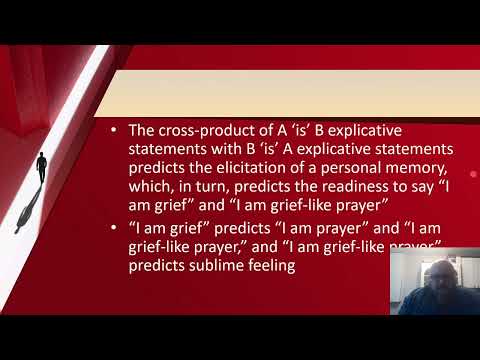 Speaker: Dr. Shawn Douglas
Speaker: Dr. Shawn Douglas
 Affiliation: University of Alberta
Affiliation: University of Alberta
Title: Emergent Meaning II. An SEM model of the relations between the emergent meaning of poetic metaphors, metaphors of personal identification, and sublime feeling
Abstract (long version below): We will report evidence that the emergent meanings of poetic metaphors mediate the effects of reflective explication on metaphors of personal identification and sublime feeling (Kuiken & Douglas, 2017; 2018). An SEM model of undergraduate readers identified a path that led from explicative statements whose interaction (AisB*BisA) described both the topic and vehicle to (1) metaphors of personal identification (Cohen, 1999) and then (2) sublime feeling (Kuiken et al., 2012). Results also suggested that personal memories contributed to the meanings that emerged from this complex metaphoric process. Moreover, this pattern was observed in a replication study.

 Long abstract
Long abstract
Four groups of participants responded to the same textual stimuli (i.e., extracts of narratives that portray the inner perspective of characters with dementia). These groups consisted of (1) people with dementia, (2) family carers of people living with dementia, (3) student social workers and (4) members of the general public. In our analysis, we find very interesting differences and similarities across the four groups in the way readers position themselves towards characters and events.
In this paper, we explore a traditional concern of cognitive stylistics and cognitive narratology – the complex interplay between text and reader. We address this ‘black box’ of literary response with the aim to unpack the factors that come into play. We pay attention to both the textual cues that seem to trigger responses (bottom-up processing), and the aspects of readers’ experiential background (Caracciolo, 2014) that can influence responses (top-down processing). We discuss how readers’ individual and collective experiences and identity in relation to dementia bring to bear on their responses. We will also make links to the conference topic of diversity and inclusion, such as the diversity of characters in dementia fiction, or the importance of doing research with people with dementia making sure that their voices are included in the research (in line with the disability rights motto ‘Not about us without us’).

